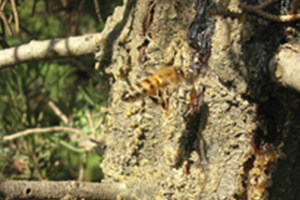
This month marks the two-year anniversary of the start of my serial history on the evolution of the honey bee. It has been my wish to explore the deep origins of things we regularly observe in our colonies and to give the biological bases for the practices beekeepers do to maximize bee health and honey crops. The fact that 24 months have passed and we aren’t close to the final chapter is testimony to the deeps we are plumbing. The modern honey bee colony is the product of an evolutive process in which the re-shuffled genomes of each generation are pitted against a new season’s challenges and gifts, with the winning combinations rewarded with another opportunity to reproduce. Each iteration improves the “fit” of the species with the habitat it occupies. As our bee moved from a solitary to increasingly social species, genes that formerly served in solitary contexts were coopted into new social functions. As colony members increased in number, the opportunities grew for spontaneous emergent order as each member made independent decisions based on her immediate local conditions. Innate behaviors and preexisting physical constraints allied to create such marvels as the beeswax comb, winter thermoregulation, symbolic dance language, and group decision making. Self-regulating feedback loops and stops in the bee colony mirrored similar things that were evolving in the cells and tissues of metazoan animals like ourselves. The language of science becomes inadequate to capture the wondrous and tapestried connectivity of it all. I am reminded of the faun Tumnus in C.S. Lewis’s fictional Narnia when Tumnus grasps for words to describe the new world he is seeing for the first time: it’s “like an onion: except that as you continue to go in and in, each circle is larger than the last.1”
In the case of the genus Apis, this great experiment has been repeating for 30-40 million generations2, and in the case of one of its youngest members, Apis mellifera, for 6-8 million generations.3 And the story of the honey bee – and her descendants – will not end as long as there is a viable planet Earth to contain it.
So I am in no danger of running out of material for monthly columns.
This month I want to turn our attention to the topic of immunity in the superorganism. Bearing in mind that superorganisms do the sorts of things that organisms do, it’s no surprise to learn that there are integrated behaviors and phenomena in the honey bee colony that deter the entry and proliferation of pathogens and parasites in the nest. There are parallels to the immune systems of organismal creatures such as ourselves4, but when the focus is on the superorganism the term most commonly used is “social immunity.”
Before we get started, I need to point out that immunity against pathogens exists in the honey bee at two levels of organization – the level of individual bee and the level of colony. Individual bees express innate immunity with a variety of means shared with other insects. These include initial defenses such as antimicrobial secretions on the integument, microbe-hostile gut chemistry, and the physical barrier of the gut lining. If pathogens breach these outer defenses, they next encounter cellular and humoral (body fluid) resistances such as enzymes that degrade pathogens, cells that engulf pathogens, antimicrobial peptides, and cells that promote melanization – a process analogous to scar tissue formation in mammals that walls off invading cells.5
Even though honey bees boast a full repertoire of these immune classes, they are relatively impoverished in the gene richness of those classes. Compared to two widely studied solitary insect groups – fruit flies in the genus Drosophila and mosquitoes in the genus Anopheles – honey bees possess about one-third fewer immune genes6, and the genes they retain appear to be very ancient. In other words, honey bees have not kept pace with solitary insects when it comes to richness and diversity of immune responses. The two best explanations for this are that (1) bees tend to be attacked by a fairly small number of highly coevolved pathogens, thus narrowing the range of demands on immunity, or (2) the innovation of social life – and simultaneous evolution of social immunity – have down-graded selection pressures for individual innate immunity.7 For the individual, it appears, social life decreases costs for disease resistance.
For our present purposes it is social immunity we want to focus on. But it is important for readers to understand that individual innate immunity is still live and well, acting as another layer of immunity in the colony. I organize my following synopsis of social immunity with the “sequential lines of defense” approach used by Cremer et al.8
Let’s look first at the possible modes of parasite transmission. Epidemiologists recognize two: the first is parasite transmission that happens between parent and offspring. This is called vertical transmission, and in the case of honey bees it is best understood as transmission between a parent colony and its swarm. The second mode of transmission happens between two members of the same generation. This is called horizontal transmission, and in honey bees this happens when parasites are transmitted between colonies. Of the two, horizontal transmission is expected to select for more virulent pathogens.9
The first line of social defense is to prevent the “uptake” of parasites by individual nest members. As biotic threats to a nest are by definition external to the nest, the members most prone to parasite uptake are …
Photo Caption
Figure 1. A forager bee collecting tree resin.


